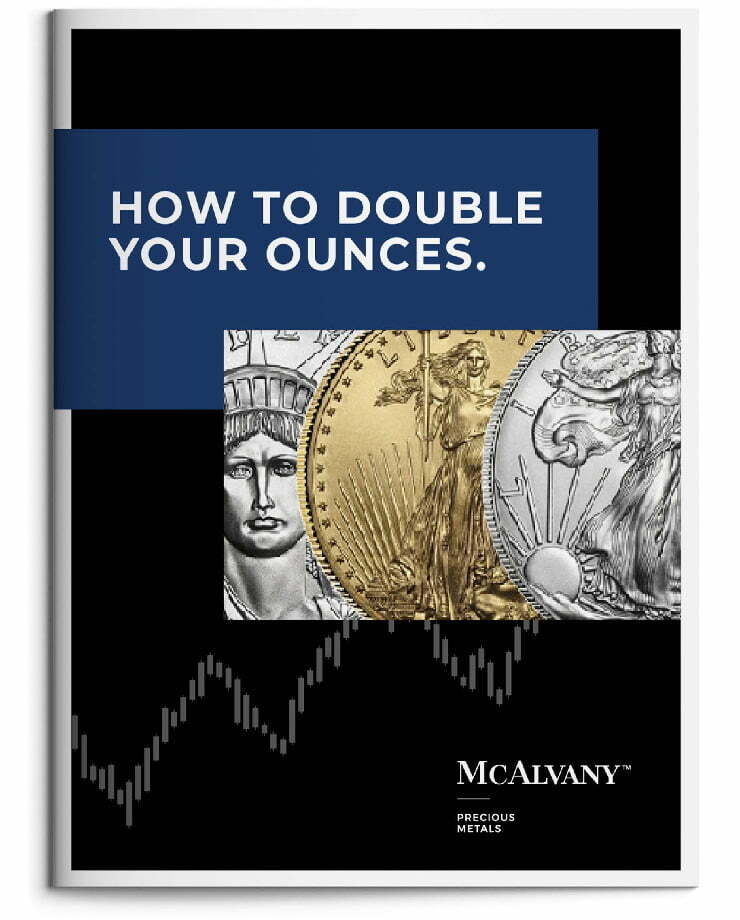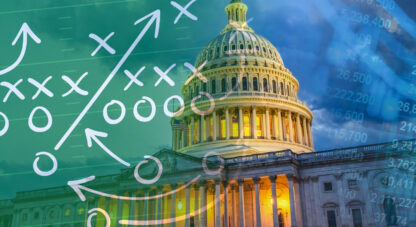The Foothills of Gold’s Eventual Everest
The main event in markets this week was news that an obscure Chinese start-up artificial intelligence (AI) company released “DeepSeek R1,” a new AI model that apparently outperforms even the best Western AI models at a fraction of the cost. Furthermore, DeepSeek was released “open source” (developed collaboratively and made available to the public for free), a move that potentially threatens Wall Street hopes for a return on investment for Western companies that have poured billions into the ever-escalating AI arms race.
Tech legend and co-founder of Netscape Marc Andreessen gave DeepSeek instant credibility this week when he said, “DeepSeek R1 is one of the most amazing and impressive breakthroughs I’ve ever seen—and as open source, a profound gift to the world.” The idea that a new AI model that offered more for less was being given away, open source, sent an earthquake through the AI-related tech sector and all companies and sectors perceived as potential beneficiaries of an ongoing AI capex spend arms race. As Goldman Sachs put it, the potential “negative capex impact and a meaningful change of narrative in the U.S. AI space is worrisome in terms of the R and I in ROI [return on investment].”
There are many conflicting opinions as to the validity, extent, and ultimate significance of the DeepSeek “breakthrough,” but, if nothing else, this week’s news serves as a warning that China appears to be throwing its entire weight behind making world-class AI dirt cheap so nobody else (especially the West) can monopolize it. Furthermore, the unexpected news and the resulting initial hit to AI-related asset prices (Nividia down nearly 18% on Monday) exposes the potentially shaky foundations of the AI bubble—and, by extension, the potentially shaky foundations of the massive financial asset bubble more broadly. If investors begin to sour on the big tech Mag-7 due to the combination of major AI-related capital spending commitments and questionable revenue opportunities due to new high-quality open source AI models, the S&P mega-bull could turn roaring bear in a hurry.
Last week HAI discussed the significant costs that accrue over time for the issuer of both the global reserve currency (the dollar) and global reserve asset (U.S. Treasuries), and argued that the U.S is currently suffering the excessive strains of late-stage Triffin’s Dilemma-like dynamics.
To review, “Triffin’s Dilemma” posits that the benefits of being the reserve currency nation initially outweigh the costs, but over time the costs outweigh the benefits and the system becomes untenable and unsustainable.
Put simply, Triffin’s Dilemma argues that while the benefits to global reserve currency status stay relatively static, inherent flaws in the system continue to compound the costs. Tension builds, and eventually the system hits a breaking point.
As HAI argued last week, with an inflation problem, a massive debt and deficit problem, a domestic manufacturing problem, and a trapped Fed now unable to effectively use interest rate policy, the U.S. is already suffering the disproportionate costs part of the dilemma. We’ve hit the breaking point for the post-1971 dollar-based global monetary system.
This week, right on cue, in an interview on VRIC, commodity expert Leigh Goehring of HAI-favorite commodity research firm Goehring & Rozencwajg stated that, “we believe we are on the cusp of a major monetary regime change… There is something going on behind the scenes… The whole [global central bank community] is preparing itself for a significant and huge monetary regime change that is going to devalue financial assets, and devalue money versus gold and hard assets… I think we’re beginning to see that now.”
Goehring’s comments couldn’t be timelier. In HAI‘s view, late-stage Triffin’s Dilemma is already hitting the U.S. hard, and a “major monetary regime change” is the likely outcome. We now have numerous indications suggesting that the Trump administration both understands our Triffin-like dilemma and plans to bring about that major monetary regime change alluded to by Goehring—imminently.
Back in June of last year, now-Treasury Secretary Scott Bessent sent the first clue that monetary regime change was a likely policy goal of a Trump presidency. At the Manhattan Institute, Bessent said, “I could see in the next few years that we are going to have to have some kind of a grand global economic reordering, something on the equivalent of a new Bretton Woods… There’s a very good chance that we are going to have to have that over the next four years, and I’d like to be a part of it.”
In November, Stephen Miran, Trump’s new head of the Council of Economic Advisors, penned a report titled, “A User’s Guide to Restructuring the Global Trading System.” In it, Miran lays out a number of ways the U.S. could restructure the global trading system and reverse the global capital flows that have defined the post-1971 U.S. dollar-centric global monetary system.
In what he calls a potential “Mar-a-Lago Accord,” Miran gives form to a 21st Century version of a new multilateral currency agreement whose ultimate aim is a weaker dollar that allows a rebuild and revitalization of the atrophied U.S. manufacturing base. As Miran puts it, “A reduction in the value of the dollar helps create manufacturing jobs in America and reallocates aggregate demand from the rest of the world to the U.S.” To accomplish these administration objectives, Miran lists a set of potential policy proposals that’s nothing short of radical.
He cites the International Emergency Economic Powers Act (IEEPA), signed into law by President Jimmy Carter in 1977, as legal authority that “gives the President sweeping powers over international transactions in response to foreign-origin threats ‘to the national security, foreign policy, or the economy of the United States.’” One notable proposal is the suggestion that the Fed, following the currency policy objectives of the Treasury, could “print dollars” to buy foreign currencies, “given the Fed’s ability to create money supply at will,” in order to strengthen foreign currencies and thereby weaken the dollar.
Crucially, Miran also suggests that the IEEPA can be “used to disincentivize the accumulation of foreign exchange reserves, if the Administration wills it. If the root cause of dollar overvaluation is demand for reserve assets, Treasury can use IEEPA to make reserve accumulation less attractive. One way of doing this is to impose a user fee on foreign official holders of Treasury securities, for instance withholding a portion of interest payments on those holdings.”
In other words, Miran is suggesting that if international demand for dollars and U.S. Treasuries as a reserve asset under the petrodollar system is the root cause of an overvalued dollar, and by extension the root cause of the now uncompetitive and hollowed-out U.S. manufacturing base, the government can refuse to pay the yield on Treasuries to disincentivize their accumulation by foreign governments. This is indeed radical. In fact, it is nothing short of an outright attack on the current structure of the post-1971 U.S. dollar-based monetary system—from inside the policy-making circles of the U.S.
Over the last year, HAI has discussed at length what Jeff Currie, former Global Head of Commodities Research at Goldman Sachs, has called the shift from “dollar recycling” to “gold recycling.” Currie is referring to a shift on the margin, primarily among BRICs nations, away from Treasuries and toward gold as the preferred global reserve asset for national savings. The new profound implication from Bessent’s description of a Bretton Woods-like “grand global economic reordering” and from Miran’s radical proposals to weaken the dollar is that perhaps now this new U.S. administration is also on board and supportive of a global monetary shift from the old post-1971 “dollar recycling” system to a new “gold recycling” system.
In fact, Miran states that “these policies may supercharge efforts of those looking to minimize exposure to the United States. Efforts to find alternatives to the dollar and dollar assets will intensify. There remain significant structural challenges with internationalizing the renminbi or inventing any sort of ‘BRICS currency,’ so any such efforts will likely continue to fail, but alternative reserve assets like gold…will likely benefit.”
In HAI’s view, Western consensus still appears to be miles away from recognizing the “grand global economic reordering” the Trump administration may now be about to intentionally accelerate. Indeed, as Leigh Goehring said, we may now be “on the cusp of a major monetary regime change”—one that “is going to devalue financial assets and devalue money versus gold and hard assets.” If so, as HAI strongly suspects, the Western investor will have to adjust and dramatically reallocate resources. Even with new all-time highs reached this week for the yellow metal, given the potential generational set-up, we may yet be merely in the foothills of gold’s eventual Everest.
Weekly performance: The S&P 500 was down 1.00%. Gold was up 2.02%, silver was higher by 3.46%, platinum was up 7.37%, and palladium was up 6.15%. The HUI gold miners index was up 2.23%. The IFRA iShares US Infrastructure ETF was down 2.13%. Energy commodities were volatile and down on the week. WTI crude oil was off 2.85%, while natural gas was crushed lower by 23.43%. The CRB Commodity Index was down 1.58%. Copper was down 0.97%. The Dow Jones US Specialty Real Estate Investment Trust Index was down 1.42%. The Vanguard Utilities ETF was off 1.87%. The dollar index was up 0.91% to close the week at 108.22. The yield on the 10-yr U.S. Treasury was down by 9 bps to close at 4.54%.
Have a wonderful weekend!
Best Regards,
Morgan Lewis
Investment Strategist & Co-Portfolio Manager
MWM LLC















